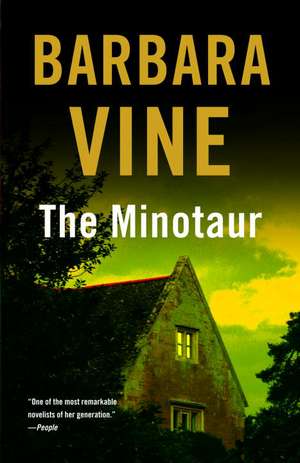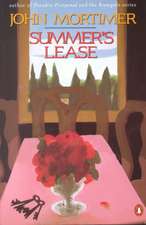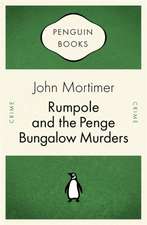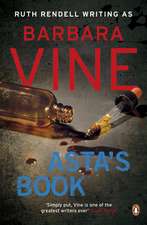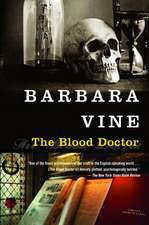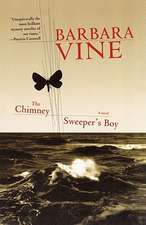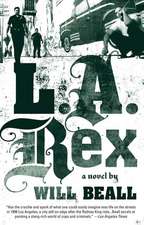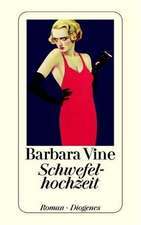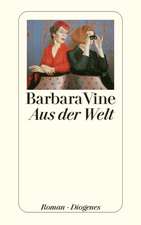The Minotaur
Autor Barbara Vineen Limba Engleză Paperback – 28 feb 2007
| Toate formatele și edițiile | Preț | Express |
|---|---|---|
| Paperback (2) | 105.40 lei 6-8 săpt. | |
| Vintage Books USA – 28 feb 2007 | 112.74 lei 3-5 săpt. | |
| Penguin Books – 6 mai 2009 | 105.40 lei 6-8 săpt. |
Preț: 112.74 lei
Nou
Puncte Express: 169
Preț estimativ în valută:
21.57€ • 22.63$ • 17.96£
21.57€ • 22.63$ • 17.96£
Carte disponibilă
Livrare economică 11-25 martie
Preluare comenzi: 021 569.72.76
Specificații
ISBN-13: 9780307278326
ISBN-10: 0307278328
Pagini: 341
Dimensiuni: 134 x 203 x 20 mm
Greutate: 0.25 kg
Editura: Vintage Books USA
ISBN-10: 0307278328
Pagini: 341
Dimensiuni: 134 x 203 x 20 mm
Greutate: 0.25 kg
Editura: Vintage Books USA
Notă biografică
Barbara Vine's acclaimed novels include A DarkAdapted Eye, Anna's Book, Grasshopper, and The Blood Doctor. Both Vine and Rendell have won many awards for literary accomplishment, including three Edgar Awards and four Gold Daggers.
Extras
1
I AM A CARTOONIST.
We are thin on the ground, we women cartoonists; it's still thought of as a man's job, and there are even fewer of my sort who aren't English and never went to art school. Over the close-on thirty years that I have been contributing a couple of cartoons to each issue of a weekly news magazine, I have drawn Harold Wilson and Willy Brandt, Mao Zedong and Margaret Thatcher (hundreds of times), John Major, Neil Kinnock, David Beckham, and Tony Blair (nearly sixty times). People say I can catch a likeness with a few strokes and squiggles; they know who it's supposed to be before they read the caption or the balloon coming out of a character's mouth. But I was no child artist prodigy, I don't remember learning anything about art at school and for years all I ever drew was a Dog Growing for my small niece and nephew.
I'll tell you about the Dog Growing because you may want to make one for your own children. You take a sheet of paper; a letter-sized sheet, cut vertically in half, will do very well. Then you fold it in half again and fold the folded-over piece back on itself to make an inch-wide pleat. Flatten it our again and draw a dog across the folds. It's best to make it a dachshund or a basset hound because it should have a long stretch of body between forelegs and hindlegs. Then refold your paper into its pleat. The dog now has a short body but when the child opens the pleat the dog grows into a dachshund. Of course, when you get practiced at it, you can make a Giraffe's Neck Growing or a Turkey Growing into an Ostrich. Children love it and that was all I ever drew all through my teens and when I was at university.
I was going to be a nurse and then I was going to reach English. I never considered drawing as a career because you can't make a living out of a Dog Growing. It was in the late sixties when I came to England, fresh from the University of Lund and my English degree and with a fairly humble nursing qualification. I had a job lined up and a place to live, but my real motive in coming was to renew my love affair with Mark Douglas.
We had met at Lund, but when he graduated he had to go home and all his letters urged me to follow him. Get a job in London, get a room. Everyone in London, he wrote, lives in a bedsitter. I did the next best thing and got a job in Essex, near the main line from Liverpool Street to Norwich. The family who was employing me was called Cosway, and the house they lived in, Lydstep Old Hall. I had never in my life seen anything like that house.
It was very large yet it hardly looked like a house at all, more a great bush or huge piece of topiary work. When I first saw it in June it was entirely covered, from end to end and from foundation to the line of the roof, in intensely green Virginia creeper. I could see it was oblong and that its roof was almost flat but if there were architectural features such as balconies, railings, recessed columns, stonework, none showed through the mass of glossy green. Windows alone peeped out of this leafy wrapping. It was a rather windy day and, because the breeze set all the hundreds of thousands of leaves shivering, there was an illusion that the house itself moved, shrank, expanded, and subsided again.
"Be like living inside a tree," said the taxi man as I was paying him. "You'd think all that stuff would damage the brickwork. I wouldn't fancy it. Friends of yours, are they?"
"Not yet," I said.
Lydstep Old Hall was the first thing I ever drew. Apart from Dogs Growing, that is. I drew it that night, from memory as I was inside the house, and that is how I have drawn everything ever since.
Mark's sister-in-law Isabel Croft got me the job. She had been at school with the youngest Cosway girl.
"Zorah won't be living at home any longer," she said when I asked her to tell me about the family. "I don't really know who will. Ida, certainly. She housekeeps for them. Her other two sisters I never knew well. They may have married or gone to live elsewhere. The house actually belongs to John."
"The one I'm to have charge of? He's schizophrenic, is that right?"
"I don't know," she said. " `Charge' is rather a strange word to use."
"Mrs. Cosway's," I said, "not mine."
"I never heard a name for what's wrong with John," Isabel said. "It rather puzzles me--but there, I expect Mrs. Cosway knows what she's talking about. There's a trust to administer the estate. It's a strange business, something to do with the way Mr. Cosway left things in his will. I don't suppose you want to know the details. His marriage had gone wrong, I think, and he and Mrs. Cosway hardly spoke to each other in his last years. Mrs. Cosway was always nice to me, but she is rather a difficult woman. Well, you'll see. The house is very big, but they keep some of the rooms shut up."
I asked her what she was going to say about being puzzled. She hadn't finished her sentence.
"I was going to say I wouldn't have thought John needed looking after. You've been a nurse and he didn't need a nurse when I knew him. Of course he sometimes behaved strangely, but he never did any harm. But I don't really know."
There were so many things she didn't say. Most of them she simply knew nothing about. The Cosways were good at keeping things hidden--from other people and one another.
In the novels of the nineteenth century which I had read while studying English, girls taking posts in country families are always met at the nearest station by some old retainer with a pony and trap. No such offer had been made to me. The Cosways had neither retainer nor pony and the one car they possessed was used by Ella Cosway to go to work. I took a taxi. There were always taxis outside Colchester station and still are for all I know.
The route it followed has been much built up since then and the old road has become a three-lane highway. We drove along winding lanes, some of them narrow, for part of the way following the valley of the River Colne, passing the gates of several great houses. I had read a little about the architecture of Essex and knew that the county lacked building stone. Wood, brick, chalk, and flint were the materials used and another material called pudding stone, oblong and rounded pebbles of flint, much used in the construction of churches and of some walls. But the most important material of all was timber and I gazed out of the taxi window, happy to see the information I had read of confirmed in mansions and farmhouses built of tiny Tudor bricks with weatherboarding and half-timbering. Of course it aroused my expectations of what the house I was going to would be like, for Isabel had never described it. It might have a moat, as some did, part of its roof might be thatched, its windows mullioned and its woodwork bare and unstained. And then there was the maze.
"In the grounds, do you mean?" I'd said to her. "Made of hedges?"
But she only laughed and said, "You'll see."
My excited anticipation made me ask the driver how much farther it was, and when he said two miles, I had to restrain myself from telling him to hurry up. We bypassed the village but no matter where you were within five miles of Windrose you could hardly fail to see the church, All Saints, its tall rose-red tower a landmark which drew and held your eyes. The Great Red Tower of Windrose, people called it, and some said the name of the village came from its color. Lydstep Old Hall was about half a mile farther on, at the top of a long hill. We approached it along a cart track which the taxi man called a "drive" and which had been graveled over where it opened out and the house was reached. There was no sign of a maze in this part of the grounds, only grass and ancient oak trees and holly.
The front door, of weathered oak, was of course set back, a rectangular hole deep in the green canopy. Now they were close to my eyes, I saw how large each shiny leaf was and, when one brushed my face, felt how cool it was to the touch. You can sometimes only tell an artificial houseplant from a real one by touching its leaves, and then there's no doubt. The imitation one feels stiff and dead while the real seems to breathe and yield under your fingers. The leaf that touched my cheek was like that.
I rang the bell and a woman came to the door. You may have seen her picture in the papers and on the television, though there weren't many of these and it was so long ago. None of the photographs of family members were good likenesses. The drawing I made of her was nearer, though perhaps it's vain of me to say so. At first I thought she must be an employee. She looked about fifty and wore one of those crossover overalls, the staple of sitcom dailies.
She held out her hand and said, "I am Ida Cosway. How do you do?"
The hand she gave me was hard and callused, red and work-damaged.
"Kerstin Kvist," I said and followed her into the hallway, humping my two suitcases.
No description of the inside of that house appeared in the papers and I shan't describe it now. Later on I will give some idea of how it was. I shall just say now that this hallway was the oldest part, an ancient vestige of a house which may have dated back to before Tudor times and which Ella Cosway told me had stood on this spot when the Battle of Agincourt was fought. The fine timbering I hoped to see showed on the plastered walls and low ceiling and there was some carving, vague shapes of roses and shields, half-obliterated by time and wear. Facing the front door was a great inglenook fireplace of red and black bricks.
Ida asked me if I had eaten and, when I said I had, offered me a cup of tea. Swedes drink far more coffee than tea, but I accepted because I disliked the thought of being shown to my room before I had made my situation and the terms under which I was prepared to work here clear to her (in case her mother had kept them to herself) and found out a little more about this family. She took my cases from me and placed them side by side at the foot of the staircase, rather a mean staircase for such a large house with such a noble hallway, its treads covered in linoleum and its wooden banister rail attached to the bare wall by metal struts. We went down a passage into the kitchen, very large and reasonably well appointed, but the height of its ceiling, all the pots and pans and a lantern hanging from a big black iron contraption the shape of a drying rack, made me think of a film I had seen set in the eighteenth century where food was prepared in just such a place. There were a table and a number of assorted chairs, armchairs as well as the upright kind, and a sofa covered in a blue check blanket.
"Do sit down," Ida said in her lifeless voice. "You must be tired from your journey."
"Not really," I said. "I should like to go out for a walk later."
"Goodness," she said. The monotonous tone she invariably spoke in made it unclear whether this was uttered in admiration for my hardihood or dismay at my folly. "Sugar?"
"No, thank you," and I added hastily, "and no milk either."
I had stopped her just in time. The habit of putting milk into an infusion of leaves has always struck me as bizarre. I watched with relief as she passed me a large saucerless mug of neat brown tea, clear as the water of the Colne was in those days.
"Are your mother and your brother at home?" I asked her.
"Mother is out with John." I nodded, though the day was gray and the wind rising all the time. "He insists on going out and she doesn't care for him to go alone." She managed to smile at me, a smile that aged her by sending wrinkles up her cheeks and around her eyes. "I expect that will be one of your jobs. They'll soon be back."
"Perhaps you'll tell me something of what I'll be expected to do for him. Your mother's letters said very little."
"What excellent English you speak," she said. "Really, I didn't expect it."
"All Swedes speak English." This was an exaggeration, though most do. "They wouldn't get very far if they didn't. You were telling me about your brother."
"Yes," she said. "John, yes."
I sensed she disliked the idea and was trying to avoid it, but lacked the cunning or conversational skills to do so. In the ensuing silence, I drank my tea and studied her. She was a tall woman, as tall as I am, and I, to use the system then used in England, am five feet nine. The drawing I did of her four or five weeks later shows a fine-boned face as rough and neglected as her hands, and gray-threaded hair as dull as her dark brown tweed skirt. Perhaps my cartoonist's habit of exaggerating a subject's outstanding feature came into play here, for I doubt if Ida can have been as round-shouldered as she is in my sketch. Whether I rendered the tension that seemed to grip her, I can't tell. It intensified as I pressed her to tell me more about her brother, though I tried to speak gently.
She spoke more rapidly, as if anxious to say what had to be said as fast as possible, so that pleasanter things could be discussed. "He was quite normal as a little boy. Later on he began to get--strange. My mother has her own theories as to what started it off and so does our doctor, Dr. Lombard. He treats John. He needs constant care--well, watching."
"I'm very sorry. Your mother takes care of him?"
I AM A CARTOONIST.
We are thin on the ground, we women cartoonists; it's still thought of as a man's job, and there are even fewer of my sort who aren't English and never went to art school. Over the close-on thirty years that I have been contributing a couple of cartoons to each issue of a weekly news magazine, I have drawn Harold Wilson and Willy Brandt, Mao Zedong and Margaret Thatcher (hundreds of times), John Major, Neil Kinnock, David Beckham, and Tony Blair (nearly sixty times). People say I can catch a likeness with a few strokes and squiggles; they know who it's supposed to be before they read the caption or the balloon coming out of a character's mouth. But I was no child artist prodigy, I don't remember learning anything about art at school and for years all I ever drew was a Dog Growing for my small niece and nephew.
I'll tell you about the Dog Growing because you may want to make one for your own children. You take a sheet of paper; a letter-sized sheet, cut vertically in half, will do very well. Then you fold it in half again and fold the folded-over piece back on itself to make an inch-wide pleat. Flatten it our again and draw a dog across the folds. It's best to make it a dachshund or a basset hound because it should have a long stretch of body between forelegs and hindlegs. Then refold your paper into its pleat. The dog now has a short body but when the child opens the pleat the dog grows into a dachshund. Of course, when you get practiced at it, you can make a Giraffe's Neck Growing or a Turkey Growing into an Ostrich. Children love it and that was all I ever drew all through my teens and when I was at university.
I was going to be a nurse and then I was going to reach English. I never considered drawing as a career because you can't make a living out of a Dog Growing. It was in the late sixties when I came to England, fresh from the University of Lund and my English degree and with a fairly humble nursing qualification. I had a job lined up and a place to live, but my real motive in coming was to renew my love affair with Mark Douglas.
We had met at Lund, but when he graduated he had to go home and all his letters urged me to follow him. Get a job in London, get a room. Everyone in London, he wrote, lives in a bedsitter. I did the next best thing and got a job in Essex, near the main line from Liverpool Street to Norwich. The family who was employing me was called Cosway, and the house they lived in, Lydstep Old Hall. I had never in my life seen anything like that house.
It was very large yet it hardly looked like a house at all, more a great bush or huge piece of topiary work. When I first saw it in June it was entirely covered, from end to end and from foundation to the line of the roof, in intensely green Virginia creeper. I could see it was oblong and that its roof was almost flat but if there were architectural features such as balconies, railings, recessed columns, stonework, none showed through the mass of glossy green. Windows alone peeped out of this leafy wrapping. It was a rather windy day and, because the breeze set all the hundreds of thousands of leaves shivering, there was an illusion that the house itself moved, shrank, expanded, and subsided again.
"Be like living inside a tree," said the taxi man as I was paying him. "You'd think all that stuff would damage the brickwork. I wouldn't fancy it. Friends of yours, are they?"
"Not yet," I said.
Lydstep Old Hall was the first thing I ever drew. Apart from Dogs Growing, that is. I drew it that night, from memory as I was inside the house, and that is how I have drawn everything ever since.
Mark's sister-in-law Isabel Croft got me the job. She had been at school with the youngest Cosway girl.
"Zorah won't be living at home any longer," she said when I asked her to tell me about the family. "I don't really know who will. Ida, certainly. She housekeeps for them. Her other two sisters I never knew well. They may have married or gone to live elsewhere. The house actually belongs to John."
"The one I'm to have charge of? He's schizophrenic, is that right?"
"I don't know," she said. " `Charge' is rather a strange word to use."
"Mrs. Cosway's," I said, "not mine."
"I never heard a name for what's wrong with John," Isabel said. "It rather puzzles me--but there, I expect Mrs. Cosway knows what she's talking about. There's a trust to administer the estate. It's a strange business, something to do with the way Mr. Cosway left things in his will. I don't suppose you want to know the details. His marriage had gone wrong, I think, and he and Mrs. Cosway hardly spoke to each other in his last years. Mrs. Cosway was always nice to me, but she is rather a difficult woman. Well, you'll see. The house is very big, but they keep some of the rooms shut up."
I asked her what she was going to say about being puzzled. She hadn't finished her sentence.
"I was going to say I wouldn't have thought John needed looking after. You've been a nurse and he didn't need a nurse when I knew him. Of course he sometimes behaved strangely, but he never did any harm. But I don't really know."
There were so many things she didn't say. Most of them she simply knew nothing about. The Cosways were good at keeping things hidden--from other people and one another.
In the novels of the nineteenth century which I had read while studying English, girls taking posts in country families are always met at the nearest station by some old retainer with a pony and trap. No such offer had been made to me. The Cosways had neither retainer nor pony and the one car they possessed was used by Ella Cosway to go to work. I took a taxi. There were always taxis outside Colchester station and still are for all I know.
The route it followed has been much built up since then and the old road has become a three-lane highway. We drove along winding lanes, some of them narrow, for part of the way following the valley of the River Colne, passing the gates of several great houses. I had read a little about the architecture of Essex and knew that the county lacked building stone. Wood, brick, chalk, and flint were the materials used and another material called pudding stone, oblong and rounded pebbles of flint, much used in the construction of churches and of some walls. But the most important material of all was timber and I gazed out of the taxi window, happy to see the information I had read of confirmed in mansions and farmhouses built of tiny Tudor bricks with weatherboarding and half-timbering. Of course it aroused my expectations of what the house I was going to would be like, for Isabel had never described it. It might have a moat, as some did, part of its roof might be thatched, its windows mullioned and its woodwork bare and unstained. And then there was the maze.
"In the grounds, do you mean?" I'd said to her. "Made of hedges?"
But she only laughed and said, "You'll see."
My excited anticipation made me ask the driver how much farther it was, and when he said two miles, I had to restrain myself from telling him to hurry up. We bypassed the village but no matter where you were within five miles of Windrose you could hardly fail to see the church, All Saints, its tall rose-red tower a landmark which drew and held your eyes. The Great Red Tower of Windrose, people called it, and some said the name of the village came from its color. Lydstep Old Hall was about half a mile farther on, at the top of a long hill. We approached it along a cart track which the taxi man called a "drive" and which had been graveled over where it opened out and the house was reached. There was no sign of a maze in this part of the grounds, only grass and ancient oak trees and holly.
The front door, of weathered oak, was of course set back, a rectangular hole deep in the green canopy. Now they were close to my eyes, I saw how large each shiny leaf was and, when one brushed my face, felt how cool it was to the touch. You can sometimes only tell an artificial houseplant from a real one by touching its leaves, and then there's no doubt. The imitation one feels stiff and dead while the real seems to breathe and yield under your fingers. The leaf that touched my cheek was like that.
I rang the bell and a woman came to the door. You may have seen her picture in the papers and on the television, though there weren't many of these and it was so long ago. None of the photographs of family members were good likenesses. The drawing I made of her was nearer, though perhaps it's vain of me to say so. At first I thought she must be an employee. She looked about fifty and wore one of those crossover overalls, the staple of sitcom dailies.
She held out her hand and said, "I am Ida Cosway. How do you do?"
The hand she gave me was hard and callused, red and work-damaged.
"Kerstin Kvist," I said and followed her into the hallway, humping my two suitcases.
No description of the inside of that house appeared in the papers and I shan't describe it now. Later on I will give some idea of how it was. I shall just say now that this hallway was the oldest part, an ancient vestige of a house which may have dated back to before Tudor times and which Ella Cosway told me had stood on this spot when the Battle of Agincourt was fought. The fine timbering I hoped to see showed on the plastered walls and low ceiling and there was some carving, vague shapes of roses and shields, half-obliterated by time and wear. Facing the front door was a great inglenook fireplace of red and black bricks.
Ida asked me if I had eaten and, when I said I had, offered me a cup of tea. Swedes drink far more coffee than tea, but I accepted because I disliked the thought of being shown to my room before I had made my situation and the terms under which I was prepared to work here clear to her (in case her mother had kept them to herself) and found out a little more about this family. She took my cases from me and placed them side by side at the foot of the staircase, rather a mean staircase for such a large house with such a noble hallway, its treads covered in linoleum and its wooden banister rail attached to the bare wall by metal struts. We went down a passage into the kitchen, very large and reasonably well appointed, but the height of its ceiling, all the pots and pans and a lantern hanging from a big black iron contraption the shape of a drying rack, made me think of a film I had seen set in the eighteenth century where food was prepared in just such a place. There were a table and a number of assorted chairs, armchairs as well as the upright kind, and a sofa covered in a blue check blanket.
"Do sit down," Ida said in her lifeless voice. "You must be tired from your journey."
"Not really," I said. "I should like to go out for a walk later."
"Goodness," she said. The monotonous tone she invariably spoke in made it unclear whether this was uttered in admiration for my hardihood or dismay at my folly. "Sugar?"
"No, thank you," and I added hastily, "and no milk either."
I had stopped her just in time. The habit of putting milk into an infusion of leaves has always struck me as bizarre. I watched with relief as she passed me a large saucerless mug of neat brown tea, clear as the water of the Colne was in those days.
"Are your mother and your brother at home?" I asked her.
"Mother is out with John." I nodded, though the day was gray and the wind rising all the time. "He insists on going out and she doesn't care for him to go alone." She managed to smile at me, a smile that aged her by sending wrinkles up her cheeks and around her eyes. "I expect that will be one of your jobs. They'll soon be back."
"Perhaps you'll tell me something of what I'll be expected to do for him. Your mother's letters said very little."
"What excellent English you speak," she said. "Really, I didn't expect it."
"All Swedes speak English." This was an exaggeration, though most do. "They wouldn't get very far if they didn't. You were telling me about your brother."
"Yes," she said. "John, yes."
I sensed she disliked the idea and was trying to avoid it, but lacked the cunning or conversational skills to do so. In the ensuing silence, I drank my tea and studied her. She was a tall woman, as tall as I am, and I, to use the system then used in England, am five feet nine. The drawing I did of her four or five weeks later shows a fine-boned face as rough and neglected as her hands, and gray-threaded hair as dull as her dark brown tweed skirt. Perhaps my cartoonist's habit of exaggerating a subject's outstanding feature came into play here, for I doubt if Ida can have been as round-shouldered as she is in my sketch. Whether I rendered the tension that seemed to grip her, I can't tell. It intensified as I pressed her to tell me more about her brother, though I tried to speak gently.
She spoke more rapidly, as if anxious to say what had to be said as fast as possible, so that pleasanter things could be discussed. "He was quite normal as a little boy. Later on he began to get--strange. My mother has her own theories as to what started it off and so does our doctor, Dr. Lombard. He treats John. He needs constant care--well, watching."
"I'm very sorry. Your mother takes care of him?"
Recenzii
“One of the most remarkable novelists of her generation.” —People“It is not just her command of language, characterization and plotting that makes her a master, but the authority of her unflinching moral vision.”–Newsday “The Minotaur, oozing with menace and malice, is a superb piece of work. It deserves to win lots of prizes”–The Evening Standard “The best mystery writer in the English-speaking world.” —Time“My dream writer. Her crime studies are subtle, mysterious affairs that never turn out quite the way you anticipate. Her characters have secret, often ugly depths that make them strangers with uncomfortably familiar features. And her prose style, so intricate in design and supple in execution, has the disquieting intimacy of an alien touch in the dark.” —Marilyn Stasio, The New York Times Book Review“Surely one of the greatest novelists presently at work in our language.” —Scott Turow“Those who haven’t read her books have missed something unique and wonderful.” —Tony Hillerman“Barbara Vine has transcended her genre by her remarkable imaginative power to explore and illuminate the dark corners of the human psyche.” —P. D. James“Unequivocally the most brilliant mystery writer of our time. She magnificently triumphs in a style that is uniquely hers and mesmerizing.” —Patricia Cornwell“Her clear, shapely prose casts the mesmerizing spell of the confessional.” —The New Yorker“One of the finest practitioners of her craft in the English-speaking world.” —The New York Times Book Review
Descriere
Renowned mystery writer Ruth Rendell (writing as Barbara Vine) draws on the conventions of the 19th-century novel to tell a chilling and suspenseful story of cruelty and murder in a bitterly divided family.
